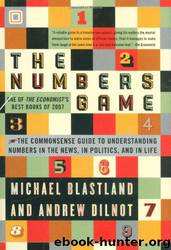The Numbers Game by Michael Blastland; Andrew Dilnot

Author:Michael Blastland; Andrew Dilnot
Language: eng
Format: mobi, epub
Tags: Non-fiction
ISBN: 9781440655272
Publisher: Gotham Books
Published: 2008-12-25T10:00:00+00:00
Let’s do it properly. What is the baseline risk of colorectal cancer? There are two ways of describing it—an obscure one and an easy one. Skip this paragraph if you don’t fancy obscurity. First the way the AICR report does it. The incidence of colorectal cancer in the United States at the moment is about 45 per 100,000 for men and about 40 per 100,000 for women. That’s on page twenty-three. A hundred pages later, we find the 21 percent increase owing to bacon. None of this is intuitively easy to understand or conveniently presented. Media coverage was by and large even worse, usually ignoring the baseline risk altogether.
Fortunately, there is another way. Those who neglect it, whether media, cancer charities, or anyone else, ought to have a good explanation, though we’re yet to hear one. And we need endure neither the “eat bacon and die” flavor of the advice from some quarters, bland reassurance from others, nor the mire of percentage increases on rates per 100,000 from others.
Here it is:
About five men in a hundred typically get colorectal cancer in a lifetime. If they all ate an extra couple of slices of bacon every day, about six would.
And that’s it.
All the information so mangled or ignored is there in two short sentences which, by counting people, not abstract, relative percentages, are intuitively easy to grasp. You can see for yourself that for 99 men in 100, an extra couple of slices of bacon a day makes no difference to the risk of colorectal cancer, and you can decide whether to take the risk of being the one exception.
“Save our Bacon: Butty Battle!” said the notoriously populist Sun newspaper, in a reference to the overfilled traditional English sandwich. But it beat the serious newspapers for intelligible reporting of the risks, being one of very few to make it clear how many people could be affected.
It should be easy. And yet . . .
“For every alcoholic drink a woman consumes, her risk of breast cancer rises by 6 percent.”
That’s pure garbage, by the way, despite its prominence on the BBC’s TV news bulletins in November 2002, and it’s soon obvious why: if true, every woman who drank regularly—and plenty who liked an occasional tipple—would be a certainty for breast cancer in time for Christmas. A 6 percent increase with every glass soon adds up; about seven bottles of wine over a lifetime would make you a sure thing.
Not much in life is this certain, and breast cancer certainly isn’t. Still, ludicrous implausibility didn’t stop the claim making the headlines. With luck, viewers were less easily taken in than the journalists who produced the report, since this is a passing piece of innumeracy that should have been easy to spot.
So what was the real meaning of the study so mangled in the news? It was true that research had shown a link between alcohol and breast cancer, but the first thing to do when faced with an increase in risk is to try to quell the fear and concentrate on the numbers.
Download
The Numbers Game by Michael Blastland; Andrew Dilnot.epub
This site does not store any files on its server. We only index and link to content provided by other sites. Please contact the content providers to delete copyright contents if any and email us, we'll remove relevant links or contents immediately.
| Biomathematics | Differential Equations |
| Game Theory | Graph Theory |
| Linear Programming | Probability & Statistics |
| Statistics | Stochastic Modeling |
| Vector Analysis |
Weapons of Math Destruction by Cathy O'Neil(5037)
Factfulness: Ten Reasons We're Wrong About the World – and Why Things Are Better Than You Think by Hans Rosling(4021)
Factfulness_Ten Reasons We're Wrong About the World_and Why Things Are Better Than You Think by Hans Rosling(2754)
Descartes' Error by Antonio Damasio(2731)
A Mind For Numbers: How to Excel at Math and Science (Even If You Flunked Algebra) by Barbara Oakley(2691)
TCP IP by Todd Lammle(2639)
Applied Predictive Modeling by Max Kuhn & Kjell Johnson(2478)
Fooled by Randomness: The Hidden Role of Chance in Life and in the Markets by Nassim Nicholas Taleb(2413)
The Book of Numbers by Peter Bentley(2404)
The Tyranny of Metrics by Jerry Z. Muller(2401)
The Great Unknown by Marcus du Sautoy(2186)
Once Upon an Algorithm by Martin Erwig(2149)
Easy Algebra Step-by-Step by Sandra Luna McCune(2117)
Practical Guide To Principal Component Methods in R (Multivariate Analysis Book 2) by Alboukadel Kassambara(2093)
Lady Luck by Kristen Ashley(2073)
Police Exams Prep 2018-2019 by Kaplan Test Prep(2033)
Linear Time-Invariant Systems, Behaviors and Modules by Ulrich Oberst & Martin Scheicher & Ingrid Scheicher(1983)
All Things Reconsidered by Bill Thompson III(1960)
Secrets of Creation, Volume 1: The Mystery of the Prime Numbers by Watkins Matthew(1864)
